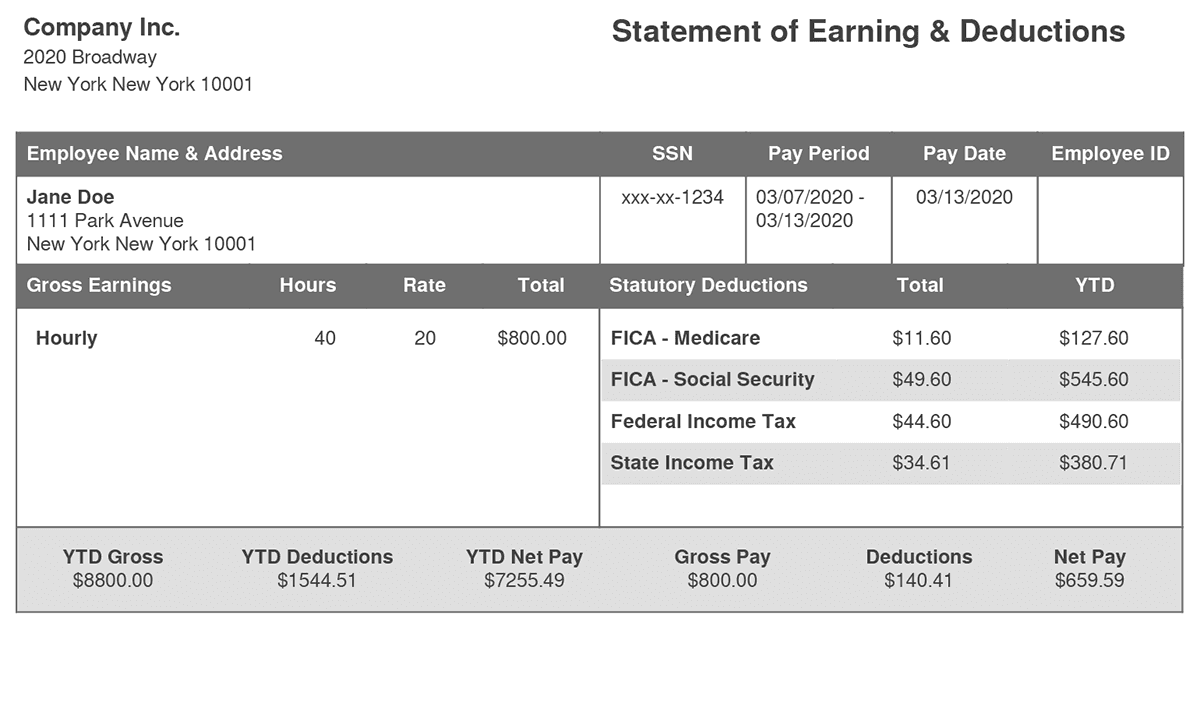Differences Between Payday, Pay Period And Pay Cycle

Employers, workers, and independent contractors must understand three important payroll terms: payday, pay period, and pay cycle. In order to manage payroll effectively, business owners must be able to set up payroll systems that accurately calculate and pay workers. Moreover, the employer should clearly explain the pay process to all staff members.
In this article, we define key payroll terms, explain what appears on a paystub, and provide a real-world payroll calculation example.
Table of Contents
Understanding the Definitions Associated with Pay Period

Understanding how your pay stub displays income and tax withholdings starts with learning three key terms: payday, pay period, and pay cycle. These terms define when and how you receive your wages and clarify what timeframe your paycheck covers.
– Payday –
A payday is the specific date on which employees or independent contractors receive their wages. It is the day an employer issues payments, either through direct deposit, paper check, or payroll card.
For instance, if a company uses a biweekly pay schedule and pays employees every two weeks, April paydays might fall on April 5th and April 19th. On the other hand, if the company follows a semimonthly schedule (twice a month), paydays could be on April 15th and April 30th.
Ultimately, payday is crucial for budgeting because it determines when employees receive their earnings and when employers process tax deductions.
– Pay Period –
The pay period refers to the timeframe when employees receive compensation for their work. It starts on a specific date and ends on another, covering the work performed or hours logged during that time. Depending on the employer’s pay cycle, the length of a pay period can vary.
For example, using the biweekly pay schedule mentioned earlier, a company paying employees on April 5th would have a pay period covering March 22nd to April 4th. Then, the next pay period would be April 5th to April 18th, with payday falling on April 19th.
For semimonthly pay, the two pay periods for April could be April 1st to April 15th and April 16th to April 30th. Although both biweekly and semimonthly schedules typically result in two paychecks per month, their pay periods don’t always align because the structure of each month varies.
Therefore, understanding the pay period is important because your paycheck’s earnings, tax deductions, and benefits contributions apply specifically to this timeframe.
– Pay Cycle –
A pay cycle outlines the company’s payroll structure—how often the company pays employees and processes payroll calculations. Company policy sets this structure, which may vary based on industry standards, employee classification (hourly vs salaried), and regulatory requirements. Common pay cycles include:
- Weekly – Employees receive wages every seven days (e.g., every Friday). This is especially common in construction, retail, and gig work.
- Biweekly – Employees receive paychecks every two weeks (e.g., every other Friday). Many corporate and healthcare organizations use this schedule.
- Semimonthly – Employees receive two paychecks per month (e.g., on the 15th and last day of the month). Many companies choose this option for salaried workers.
- Monthly – Employees receive one paycheck per month (e.g., on the last business day). Although less common, some industries use this pay schedule, especially for executive positions.
Understanding your pay cycle helps you plan your finances more effectively, since it shows how often you receive wages and how taxes and deductions apply throughout the year.
Why These Terms Matter
A pay stub breaks down an employee’s earnings, tax withholdings, and deductions based on these terms. When reviewing a pay stub, it’s especially important to distinguish between:
- Current Amounts – Earnings and deductions for the most recent pay period.
- Year-to-Date (YTD) Amounts – Cumulative earnings and deductions from the beginning of the year up to the current paycheck.
By having a clear understanding of the differences between payday, pay period, and pay cycle, employees and independent contractors can better manage their finances, anticipate deductions, and ensure they are paid correctly.
Specific Information on a Pay Stub

Employers provide this information to each employee and contractor:
— Payroll Cycle: The number of pay periods determines how much salary is paid on each payroll date. Additionally, it determines the start and ending days for computing hourly payroll.
— Wages: Gross pay and net pay. Wages may be based on a salary, or calculated using an hourly rate of pay.
— Tax Withholdings: Federal, state, and possibly local amounts withheld for taxes.
— Benefit Withholdings: Amounts withheld for the employee’s share of insurance premiums, or funds to be invested in a retirement plan.
As a result, every business must collect data to calculate gross wages and net pay. However, if you employ independent contractors, you don’t need to withhold taxes from pay.
Calculating Net Pay

Here are the details you need to calculate net pay:
1) Gross Wages
Wages earned before any withholdings or deductions are subtracted. Gross wages for a pay period amount are calculated in one of two ways:
- Salaried Employees: (Annual salary / number of pay periods in a year)
- Hourly Employees: (Hours worked X pay rate per hour)
Gross wages may include additional compensation, including sick pay, holiday pay, or bonuses.
2) Hours Worked and Pay Rate
The hours worked total is especially important for non-exempt (hourly) workers. The pay stub should include regular hours (up to 40 hours per week) as well as overtime hours.
The paystub must detail all hours worked, and the rate of pay earned for each hour. Some workers, including those covered by union contracts, must be paid a specific rate of pay for overtime or double-time hours.
*Salaried workers may also see hours listed on their pay stubs.*
3) Tax Deductions
Workers determine their federal income tax withholdings amounts by completing Form W-4, and each state has a tax withholding form.
Social Security Tax:
- Employee Contribution: 6.2% of earnings, up to a wage base limit of $176,100. This means the maximum Social Security tax an employee will pay in 2025 is $10,918.20.
- Employer Contribution: Employers match this 6.2% rate, contributing an equal amount for each employee.
Medicare Tax:
- Employee Contribution: 1.45% of all wages, with no wage base limit.
- Employer Contribution: Employers also contribute 1.45% of all employee wages.
- Additional Medicare Tax: Employees earning over $200,000 annually are subject to an additional 0.9% Medicare tax on earnings above this threshold. Employers are required to withhold this additional tax but do not match it.
In total, for employees earning up to $176,100, the combined FICA tax rate is 7.65% (6.2% for Social Security and 1.45% for Medicare). Employers also pay a combined rate of 7.65%, which is deductible as a business expense.
Here’s an example that you can review to understand the payroll process.
Example Payroll Calculation
Sally’s annual income is $60,000, and her firm processes payroll 26 times a year. Sally’s gross wages each pay period total ($60,000 / 26), or $2,308 per pay period.
Based on the allowances on her W-4, her company withholds 20% of her gross pay ($462) for federal taxes, and 5% ($115) for state taxes. Sally also pays $50 each pay period for her share of the company health insurance plan.
Sally’s net pay is $2,308, less a total of $577 for taxes, and $50 for her health insurance premiums. Her net pay is $1,681.
The pay stub must include all of this information for the current payroll period and year-to-date. The pay stubs you generate may also include unemployment tax payments. Hourly workers need details about their total hours worked, and any hours that are paid as overtime wages.
Employers need to generate accurate pay stubs, and thankfully, using technology can help.
Take Charge of the Process
FormPros provides a pay stub generator that is not only user-friendly but also helps you produce accurate pay stubs in less time. Use FormPros to take charge of the pay stub process.
FormPros Has You Covered
Simplify your paperwork with FormPros! From creating paystubs, W-2s, and 1099-NEC forms to generating LLC Operating Agreements and even voided checks, our easy-to-use platform has you covered. Save time, reduce errors, and handle your business documents with confidence. Start now and see how FormPros makes professional form generation fast, affordable, and hassle-free!
FAQs
-
Can employers offer different pay cycles to different employees?
Yes, employers can offer different pay cycles to employees based on factors like job classification (salaried vs. hourly), department, or location—as long as it complies with state labor laws and employment agreements. However, consistency within the same job type is generally encouraged to avoid confusion and payroll errors.
-
Do independent contractors ever receive paystubs?
Although not legally required, some businesses voluntarily provide pay stubs to independent contractors for record-keeping. These stubs can help contractors track their income, especially when filing taxes or applying for loans. Tools like FormPros make it easy for contractors to create their own.
-
What happens if a payday falls on a weekend or holiday?
If a scheduled payday falls on a weekend or federal holiday, employers typically process payroll one business day earlier. This ensures employees receive their wages on time. Always consult your state’s labor laws, as some require early disbursement in such cases.
-
How does switching from biweekly to semimonthly affect employee pay?
Switching pay cycles doesn't change an employee’s annual salary, but it alters the paycheck amounts and timing. Semimonthly pay results in slightly higher paychecks compared to biweekly, but they occur less frequently. Such transitions require clear communication and planning to avoid confusion.
-
Are digital pay stubs legally valid?
Yes, digital or electronic paystubs are legally valid in most states, provided employees can access and print them. Some states require employees to opt in or be given the option to receive paper copies, so employers should verify local regulations before going paperless.
-
What payroll records must employers keep, and for how long?
Employers are generally required to retain payroll records such as employee hours, wages, tax withholdings, and pay stub details for at least three years (under the Fair Labor Standards Act). Some states or regulatory bodies may require longer retention periods.
-
Can employees request corrections to their pay stubs?
Absolutely. If an employee notices errors—like incorrect hours, deductions, or tax information—they should report it immediately. Employers are legally obligated to investigate and correct any discrepancies. Providing documented proof (like timesheets) can help speed up the process.
-
How are bonuses and commissions reflected on pay stubs?
Bonuses and commissions typically appear as separate line items on the pay stub, often labeled “supplemental income.” These amounts are subject to withholding, though sometimes at a flat supplemental rate. Clear labeling helps employees understand the origin of additional earnings.
-
What happens to payroll if an employee is on unpaid leave?
If an employee is on approved unpaid leave, they won’t receive a paycheck for that period. However, employers still need to generate a record or notation in their payroll system to reflect the leave. Any benefits impacted during the leave should also be documented on the next paystub.
-
How can businesses automate payroll without hiring a full-time specialist?
Small businesses can automate payroll using online tools that calculate wages, taxes, and generate pay stubs. Platforms like FormPros streamline this process by offering templates and tax logic without the need for accounting expertise. This is especially helpful for startups and solopreneurs.